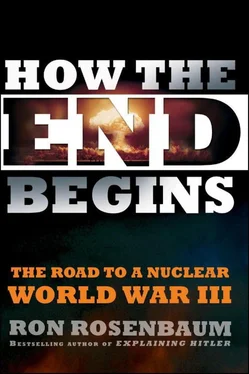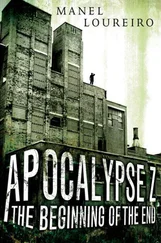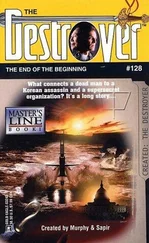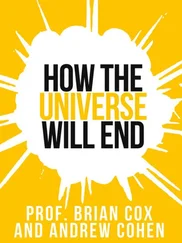The combined effect of the two phases of his proposals, if adopted by both superpowers, would be to create a kind of time-delay firewall that would replace the accident-prone, short-fuse, hair-trigger, launch on warning, command and control systems both nuclear arsenals have retained from the Cold War.
Blair’s third and fourth phase proposals—separating warheads from missiles, taking them out of the silos and putting them into storage—and then disassembling them, would make accidental nuclear war or surprise attack virtually impossible, although they would likely require more elaborate negotiations about inspection and verification of warhead removal and disassembly. They probably couldn’t be adopted as easily as Phases 1 and 2 could be. [185]
But there’s no reason the administration couldn’t start from there.
COLONEL YARYNICH’S ECHELONS
Yarynich’s seven-page plan is called “100 Nuclear Wars.” It is not the only possible solution to the urgent need for de-alerting, but it deserves careful attention because its source is someone who knows technical and strategic issues of command and control from both sides.
The best way to understand Yarynich’s “100 Nuclear Wars” is to start with START. The treaty’s goal was to reduce the number of actively deployed nuclear warheads (on missiles, bombers, and subs) from more than 5,000 on each side to a number between 1,700 and 2,200 by 2012.
START, which was signed in 1991 and after some travail has achieved both real and sham reductions. In the latter category the Bush administration announced with great fanfare in 2007 that it had reduced the number of operational warheads by two hundred but critics of the Pentagon were able to demonstrate that some of these reductions were a three-card Monte shuffle. That in some cases, the Bush reductions meant detaching the actual nuclear warheads from ballistic missiles and storing them in distant facilities so that quick “break-out” reassembly is not feasible.
But on closer inspection it turned out the storage facilities were at “full capacity” and so the warheads were “temporarily” going to be moved to warehouses on the same missile bases as the silos only minutes or hours away from being ready to be reinstalled.
But even if the reduction of missile numbers were to be carried out in good faith and verifiable on both sides, the readiness question needs to be addressed: how long after a warning signal appeared on Cheyenne Mountain radar screens could warheads be reactivated and retargeted?
And so the question became, how does one step back from the fifteen-minute readiness posture without placing oneself in danger of surprise attack? Just renouncing surprise attacks, as Blair is advocating, is not enough. There must be physical limitations to premature or preemptive firing, and that’s where Yarynich’s plan comes in. It may sound quixotic and overcomplicated but no one has come up with a simpler solution.
He would first divide all American and Russian missiles into three “echelons” depending on the time it would take to get them ready to launch. The first echelon would be about deterrence and retaliation: it would consist of large but inaccurate missiles for the most part, weapons designed to bring vast swaths of retaliatory wrath down upon a first strike attacking side. [186]They would not be first strike weapons because first strike weapons are targeted on the foe’s silos and other military installations, and require accuracy. But when it came to retaliation these first echelon weapons would be big and inaccurate in Yarynich’s scheme, but they would be ready to go and reasonably invulnerable, like submarine-launched missiles. They would not be designed for first strikes and would ensure that neither side could get very far with a surprise attack. There would have to be two decisions made by both sides about the first echelon missiles; first, both sides would have to agree on a number and mega-tonnage of missiles that would produce a level of casualties sufficient to deter surprise attack. (I know: estimating millions of deaths per megaton—and how many deaths are acceptable before deterrence takes hold—is likely to be a horrifying task, however necessary.) Secondly, both sides would have to agree on separating in time and in space the warheads from their launchers. In other words, nuclear warheads would have to be taken off ballistic missiles and stored separately from launchers so they couldn’t launch on alert, launch on warning, launch on anything but a real attack. But how much of a time delay in mounting an attack would be sufficient?
Yarynich’s plan suggests the two sides agree on a three-hour window for the first echelon of missiles to reach readiness. This would mean warheads would be stored at enough of a physical distance from the launchers to require at least three hours for transport and technical rehookup. That’s one solution. Another is to install internationally monitored time locks on storage facilities for warheads that wouldn’t permit their activation, or release from storage, without raising an alert or warning—no secret race to a middle-of-the-night surprise launch.
Yarynich’s second echelon would consist of weapons that are capable of first strike precision accuracy. Until the destruction of these weapons has been negotiated by treaty he wants to make their disassembly and distance from launch site a priority.
The third echelon would consist of all other weapons, which he suggests are mainly candidates for the scrap heap. Both superpowers still have in storage thousands of medium-range and short-range warheads that we’ve taken out of our war plans but have yet to destroy. He believes work on destroying them would be an easy first step in beginning to move from three echelons to one.
The heart of Yarynich’s idea is that he has done Monte Carlo runs of one hundred nuclear wars using the weaponry in his three echelon model, with a range of possibilities and variables they might encounter. He believes that his statistical calculations show that structuring U.S. and Russian nuclear arsenals in this way will make the outbreak of nuclear war by deliberation or inadvertence radically more unlikely.
Of course his modeling, like Blair’s proposals, is bipolar and doesn’t include the nuclear arsenals of Britain, France, and rogue states like North Korea or dangerous enigmas like Pakistan and Israel. It is limited but, considering the relatively small size of the other nuclear nations’ arsenals, it addresses the problem of 90 percent of the nuclear warheads on earth in this “play with fire” interim. And it addresses the possibility that the fire will never be put out.
Yarynich’s proposal is perhaps the graphic example of the paradox of nuclear disarmament. The more one applies reason to the matter the more unreasonable it seems to be. Yarynich’s plan, the rational division of weapons into echelons, looks impressive on paper, but seems beyond reach as a treaty when you consider how difficult the START negotiations have been for the far simpler goals of reducing the number of launchers and warheads. Sometimes I wonder if “100 Nuclear Wars” is in its way an emblematic document of the new nuclear age, the attempt to restructure the absurd into a simulacrum of reasonableness. Its larger aim is to remove the last vestiges of Cold War surprise attack/decapitation culture. Still, the concept of Monte Carlo runs in itself has an importance all its own. Not only as a way of evaluating nuclear risk—or demonstrating that such risk can vary wildly and, most importantly, unpredictably—it undermines any given attack plan and thus helps achieve stability by demonstrating the uncertainty inextricable in any such plans. This seems as persuasive to me as it may well have been to the Soviet Presidium in November 1983, thank God.
Читать дальше











